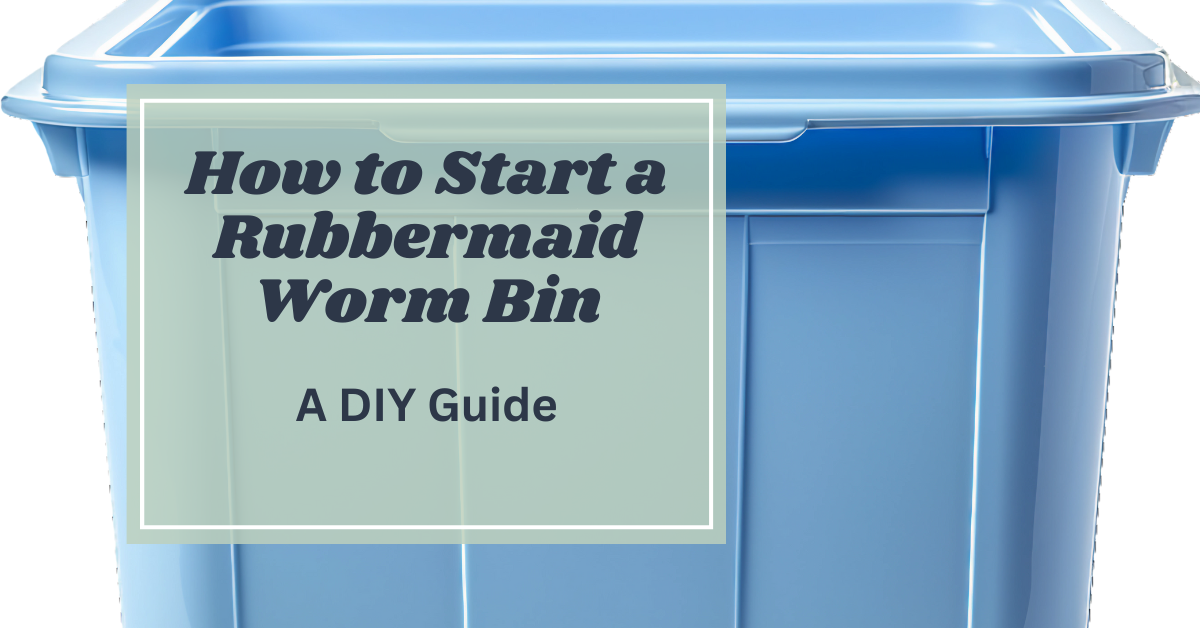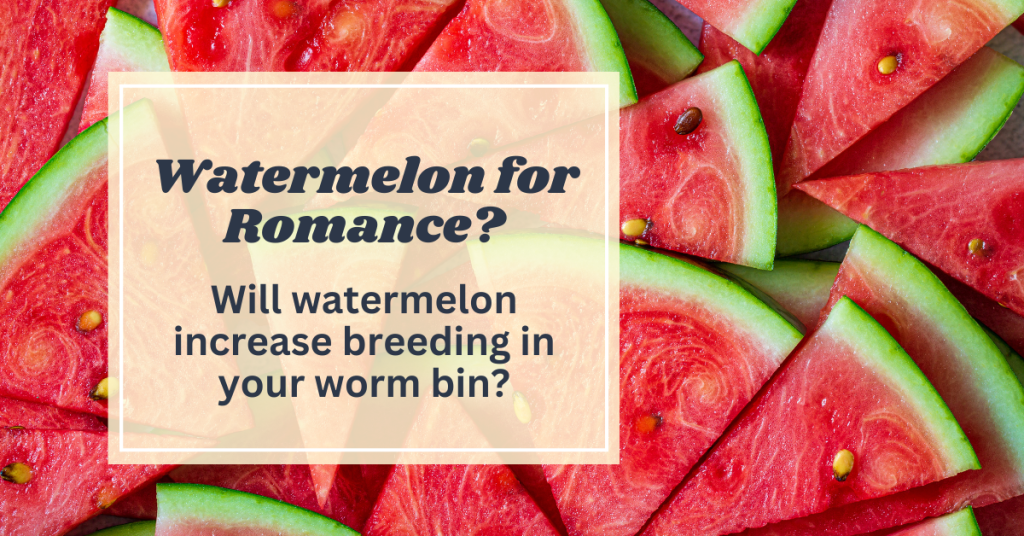How to Start a Worm Bin: Step-by-Step Guide Using a Rubbermaid Container
Please note that this post may contain affiliate links, which means we may earn a commission if you make a purchase through our links, at no extra cost to you. Learn more.
Introduction
Are you looking for an eco-friendly way to recycle kitchen scraps and create nutrient-rich compost for your plants? Starting a worm bin might be the perfect solution for you.
Vermicomposting, or composting with worms, is an efficient and odor-free method of turning organic waste into “black gold” (i.e. worm castings) for your garden.
In this DIY vermicomposting guide, we’ll walk you through the process of setting up your very own indoor worm bin using a Rubbermaid tote or a similar container.
This DIY worm bin method is affordable, space-efficient, and perfect for beginners and experienced composters alike.
Why Choose a Rubbermaid Container for Your Worm Bin?
When it comes to creating a home for your composting worms, Rubbermaid containers offer several advantages. These durable plastic totes are readily available, cost-effective, and come in various sizes to suit different spaces and composting needs.
Rubbermaid containers are ideal for vermicomposting because they’re sturdy enough to withstand the weight of moist bedding and worms. Their opaque sides help block out light, creating a dark environment that worms prefer.
Rubbermaid containers are also super easy to clean and maintain. When it’s time to harvest your vermicompost, or worm castings, you can simply transfer the contents to another container or spread them out for sorting.
Ready to make your first DIY at home worm bin? Let’s get started!
Materials Needed for Your DIY Worm Bin
Creating your own DIY vermicomposting system doesn’t require a long list of expensive materials. In fact, you probably have many of these items already lying around your home. Here’s what you’ll need to get started with your Rubbermaid worm bin:
Essential Equipment:
- Rubbermaid (or another brand!) Container: Choose a size that fits your space and composting needs. A 10 to 20-gallon tote is usually ideal for most households. You should choose an opaque container to keep the interior dark.
- Drill: You’ll use this to create air holes in your container. A regular power drill or even a hand drill will work fine.
- Bedding Material: Shredded newspaper, cardboard (corrugated is best), or coconut coir are excellent choices. These materials provide a cozy home for your worms and help regulate moisture. (Learn more about bedding here)
- Composting Worms: Red wigglers (Eisenia fetida) are the stars of your DIY worm bin. They’re efficient composters and adapt well to bin environments. They are also the most beginner-friendly vermicomposting worm choice.
- Kitchen Scraps: Fruit and vegetable peels, coffee grounds, and crushed eggshells will be the main diet for your worms.
- Water: You’ll need this to moisten the bedding material. Tap is fine though some people use rain water or tap water that has sat out for 24hrs.
Optional but Helpful:
- Trowel or Small Garden Fork: These are useful for burying food scraps and harvesting compost.
- Spray Bottle: Handy for adding moisture to your bin if it becomes too dry.
In the next section, we’ll guide you through the process of preparing your Rubbermaid container for its new role as a vermicomposting bin.
Preparing Your Rubbermaid Container for Vermicomposting
Transforming a regular Rubbermaid tote into a thriving worm bin is simpler than you might think.
The key is to create a comfortable environment that mimics the worms’ natural habitat.
Here’s how to prepare your container:
Step 1: Drill Ventilation Holes
Proper ventilation is crucial for your DIY worm bin. Worms, like all living creatures, need oxygen to survive. Good airflow also helps prevent anaerobic conditions that can lead to unpleasant odors.
Start by drilling small holes (about 1/4 inch in diameter) in the lid of your Rubbermaid container. Space these holes about 2-3 inches apart. This allows for air circulation while keeping the bin contents protected from pests.
Next, drill a series of holes around the upper sides of the container, about 2-3 inches below the rim. These side holes provide additional ventilation and help excess moisture evaporate.
Pro Tip: If you’re concerned about worms escaping, you can cover the holes with fine mesh or window screen material.
Step 2: Create a Drainage System (Optional)
While not always necessary, a drainage system can be helpful if you tend to overwater your bin.
If you’d like to use a drainage system in your DIY worm bin, you will:
- Drill several small holes in the bottom of your Rubbermaid container.
- Place this container inside a slightly larger, undrilled container. This second container will catch any excess liquid (known as “worm tea”) that drains from your main bin.
- To create space between the two containers, place a few small blocks of wood or plastic in the bottom of the larger container before setting the drilled container on top.
Step 3: Choose the Right Location
Before adding bedding and worms, consider where you’ll keep your new vermicomposting bin.
The ideal location should be:
- Away from direct sunlight to prevent overheating
- Protected from extreme temperatures (worms prefer around 55-77°F or 13-25°C)
- Easily accessible for feeding and maintenance
- In a well-ventilated area, but not drafty
Good spots for your worm bin include a garage, basement, or even under the kitchen sink. Just remember, wherever you place it, make sure it’s convenient for you to use regularly.
Creating the Perfect Bedding for Your Worm Bin
Bedding is a crucial component of your DIY worm bin, providing a comfortable environment for your worms while helping to regulate moisture levels. The right bedding will also serve as a food source as it breaks down.
Here’s how to prepare your worm bin bedding:
Step 1: Choose Your Bedding Material
Common bedding materials for vermicomposting include:
- Shredded Newspaper: A readily available option that provides excellent aeration and moisture retention. Avoid colored or glossy paper, as these can contain harmful chemicals.
- Cardboard: Similar to newspaper, shredded cardboard is a great choice. Make sure to tear it into small pieces to increase surface area.
- Coconut Coir: This natural fiber is an excellent moisture-retaining material that also provides good aeration. It can be purchased at garden centers.
Step 2: Moisten the Bedding
Once you’ve chosen your bedding material, it’s time to prepare it for your worms. Start by soaking the shredded newspaper or cardboard in water until it’s damp but not soggy.
The ideal moisture level should feel like a wrung-out sponge—moist enough to hold together without dripping water.
If you’re using coconut coir, follow the instructions on the package to hydrate it properly. Typically, you’ll add water to the coir and allow it to expand before mixing it with other bedding materials.
Step 3: Fill Your Rubbermaid Container
After moistening your bedding, add about 4-6 inches (15-20 cm) of the material to the bottom of your Rubbermaid container. This layer will provide insulation and a cozy environment for your worms.
Step 4: Test the Moisture Level
Before introducing your worms, check the moisture level one last time. You can do this by grabbing a handful of bedding and squeezing it gently. If a few drops of water come out, you’re good to go.
If it’s too dry, add a little more water; if it’s too wet, simply mix in some dry bedding.
Introducing Worms to Your DIY Rubbermaid Bin
Now that you’ve prepared the perfect home for your worms, it’s time to introduce them to their new environment!
Follow these steps to help your worms acclimate to their new environment:
- Gently spread your worms on top of the bedding. Don’t worry if they seem sluggish at first; this is normal.
- Leave the lid off and turn on a light. Worms are sensitive to light and will naturally burrow into the bedding to escape it.
- After an hour or two, check on your worms. Most should have burrowed into the bedding. If many are still on the surface, there might be an issue with the bedding (too wet, too dry, or not deep enough).
- Once the worms have settled, place the lid on the bin, ensuring it’s not airtight to allow for proper air circulation.
Creating Optimal Conditions in Your Worm Bin
To help your worms thrive in their new home:
- Temperature: Maintain a bin temperature between 55°F and 77°F (13°C to 25°C). Worms are most active and reproduce best within this range.
- Moisture: Keep the bedding moist but not waterlogged. Aim for about 70-80% moisture content.
- Darkness: Worms prefer dark environments. Keep your bin covered and in a shaded area.
- pH Level: Worms prefer a neutral pH (around 7). You can test this with pH strips if you’re concerned (but you likely won’t need to worry about it!)
Feeding Your New Vermicomposting Worms
For the first week, allow your worms to acclimate to their new environment before adding food scraps. They’ll sustain themselves on the bedding material during this time.
After a week or so, you can begin adding small amounts of food scraps. Start with about a cup of scraps, burying them in the bin.
Start Your Own DIY Worm Bin Today!
Congratulations!
By following this guide, you now have all the knowledge and tools needed to start your very own DIY worm bin using a Rubbermaid container.
Remember, starting a worm bin is just the beginning of your vermicomposting journey. To ensure the long-term success of your DIY system, be sure to regularly feed your worms, maintain optimal moisture and temperature levels, and harvest the finished compost when ready.
For more detailed information on these topics, check out our additional posts:
- What Can You Put In Your Worm Bin? (Feeding)
- How Many Worms Do I Need?
- Uninvited Guests: Dealing With Pests in Your Worm Bin
- Harvesting Worm Castings
With a little bit of care and attention, your DIY Rubbermaid worm bin will become a thriving ecet ready to embark on an exciting journey of vermicomposting and watch your garden flourish like never before!









